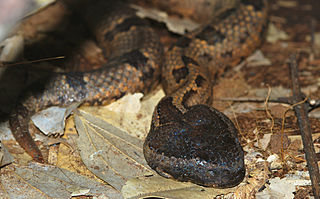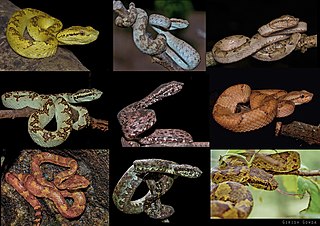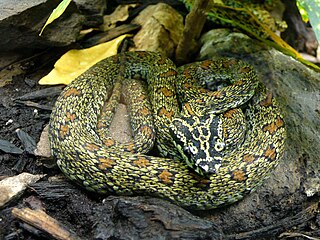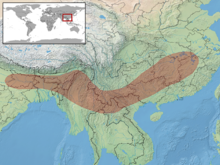
Trimeresurus is a genus of pit vipers found in Asia from the Indian Subcontinent throughout Southeast Asia, China, and the Pacific Islands. Currently 44 species are recognized. Common names include Asian palm pit vipers, Asian lanceheads, and green pit vipers.

Craspedocephalus strigatus, commonly known as the horseshoe pit viper, is a species of venomous snake in the subfamily Crotalinae of the family Viperidae. The species is endemic to the Western Ghats of India. There are no subspecies that are recognized as being valid.

Ovophis monticola, commonly known as the Chinese mountain pit viper, is a venomous pitviper species found in Asia. Currently, two subspecies are recognized, including the nominate subspecies described here. Recent taxonomic work suggests that most of these should be considered as separate species. IUCN has already evaluated O. m. makazayazaya as Ovophis makazayazaya.

Protobothrops mucrosquamatus is a venomous pit viper species endemic to Asia. Common names include: brown-spotted pit viper, Taiwanese habu and pointed-scaled pit viper. No subspecies are currently recognized. The species was first described by Theodore Cantor in 1839.

Trimeresurus albolabris, the white-lipped pit viper or white-lipped tree viper, is a venomous pit viper species endemic to Southeast Asia.

Trimeresurus erythrurus, commonly known as the red-tailed bamboo pitviper, redtail bamboo pit viper, and redtail pit viper is a venomous pit viper species found in South Asia and Myanmar. No subspecies are currently recognized.

Craspedocephalus gramineus, known as the bamboo pit viper, Indian green pit viper, or common green pit viper, is a venomous pit viper species found in the southern and north eastern parts of India. No subspecies are currently recognized.

Craspedocephalus macrolepis, commonly known as the large-scaled pit viper, is a venomous pitviper species endemic to the Southern Western Ghats of South India. No subspecies are currently recognized.

Craspedocephalusmalabaricus, commonly known as Malabar pit viper, Malabar rock pit viper, or rock viper, is a venomous pit viper species endemic to the high-moderate elevations of Western Ghats of southwestern India. Recently this species complex was split into three different species, Craspedocephalus malabaricus, Craspedocephalus travancoricus, Craspedocephalus anamallensis.

Trimeresurus medoensis, commonly named the Motuo bamboo pitviper, is a venomous pitviper species endemic to India, Burma, and Tibet. No subspecies are currently recognized.

Trimeresurus popeiorum is a species of venomous pit viper in the family Viperidae. The species is native to northern and northeastern parts of India and Southeast Asia. Common names include: Pope's pit viper, Pope's green pit viper, Pope's tree viper and Pope's bamboo pitviper.

Trimeresurus purpureomaculatus is a venomous pit viper species native to India, Bangladesh and Southeast Asia. Common names include: mangrove pit viper, mangrove viper, and shore pit viper.

Trimeresurus septentrionalis, commonly known as the Nepal pit viper or northern white-lipped pit viper, is a venomous pit viper species found in Bangladesh, Bhutan, Nepal and India.

Trimeresurus stejnegeri is a species of venomous pit viper endemic to Asia. Two subspecies are currently recognized, including the nominate subspecies described here.

Eryx conicus, also known as Russell's sand boa, the Common sand boa or the rough-tailed sand boa, is a species of non-venomous snake in the subfamily Erycinae of the family Boidae. The species is native to Southern Asia. No subspecies are recognised.

Protobothrops mangshanensis, commonly known as the Mangshan pit viper, Mangshan pitviper, Mt. Mang pitviper, or Mang Mountain pitviper, is a venomous pit viper species endemic to Hunan and Guangdong provinces in China. No subspecies are currently recognized. This is a nocturnal pit viper that is also known as the ''Mangshan iron-head snake'', ''Chinese pit viper'', and the ''Ironhead viper''. They eat frogs, birds, insects, and small mammals. They have a white tail tip that they wiggle to mimic a grub so that prey comes into striking range—a behaviour known as caudal luring. The venom causes blood clotting and corrodes muscle tissue and can be fatal to humans if not treated. Unusually for vipers, P. mangshanensis is oviparous with the female laying clutches of 13–21 eggs which she will guard until they hatch.
Protobothrops jerdonii bourreti, commonly known as Bourret's pitviper, is a subspecies of venomous pit viper in the family Viperidae. The subspecies is endemic to Vietnam.

Protobothrops xiangchengensis, commonly known as the Szechwan pit viper, Kham Plateau pitviper, or Sichuan lancehead, is a venomous pit viper species endemic to the Hengduan Mountains in south-central China. No subspecies are currently recognized.
Protobothrops kaulbacki, commonly known as Kaulback's lance-headed pitviper or Kaulback's lance-headed pit viper, is a venomous pit viper species endemic to Asia. There are no subspecies that are recognized as being valid.

Protobothrops jerdonii xanthomelas is a venomous pit viper subspecies endemic to China.





















